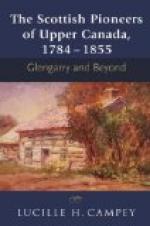The Amerindians who inhabited (more or less) the rest of the Canadian Dominion, and the whole remainder of the New World, differed in physical appearance from the Eskimo mainly in being taller and better proportioned, with shorter and rounder heads, larger, fuller eyes, a bigger nose, and a handsomer personal appearance. The skin colour, as a rule, was darker and browner than the greyish- or pinkish-yellow of the Eskimo.
The various human types that went to form the Amerindian race (beside the Eskimo element in them) seem to have entered north-west America from Asia, and first to have peopled the Pacific slopes of the Rocky Mountains, after which they wandered farther and farther south till they got into a warmer climate. Then they crossed the Rocky Mountains and peopled the centre and east of what is now the United States. As they pushed their way north up the valleys of the great rivers, they no doubt killed, mingled with, or pushed back the Eskimo. At last their northernmost extensions reached to the Mackenzie River, the vicinity of Hudson’s Bay, Labrador, and Newfoundland. But in all the middle, west, and even east of Canada they seem to have been relatively recent arrivals,[1] not to have inhabited the country for a great many centuries before the white man came, and all their recorded and legendary movements in North America have been from the south-west towards the north-east (after they had got across the Rocky Mountains). The few cultivated plants they had, such as maize (Indian corn), tobacco, and pumpkins, they brought with them or received from the south.
[Footnote 1: There may have been an earlier race inhabiting north-east America which was killed out or driven away by the last Glacial period.]
The only domestic animal possessed by either Eskimo or Amerindian was the dog. We are most of us by now familiar with the type of the Eskimo dog—a large, wolf-like animal with prick ears and a bushy tail curled over its back. In this carriage of the tail the Eskimo and most other true dogs differ from wolves, with whom the tail droops between the hind quarters. But there is a small wild American wolf—the coyote—which carries its tail more upright, like that of the true dog; and the coyote seems indeed an intermediate form between the wolf and the original wild dog. Most of the domestic dogs of the Amerindians[2] (as distinguished from those of the Eskimo) seem to have been derived from the coyote or small wolf of central North America.
[Footnote 2: “The dogs of the Northern Indians are of various sizes and colours, but all of them have a foxy or wolf-like appearance, sharp noses, bushy tails, and sharp ears standing erect.” (Samuel Hearne).
Hearne also remarks that the northern Indians had a superstitious reverence and liking for the wolf. They would frequently go to the mouth of the burrows where the female wolves lived with their young, take out the puppies and play with them, and even paint the faces of the young wolves with vermilion or red ochre.




